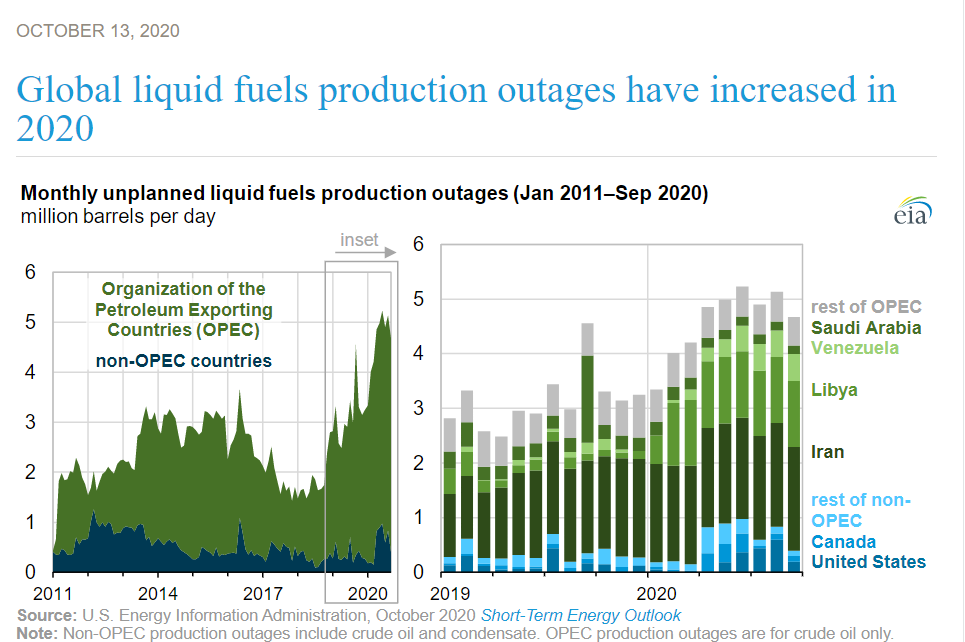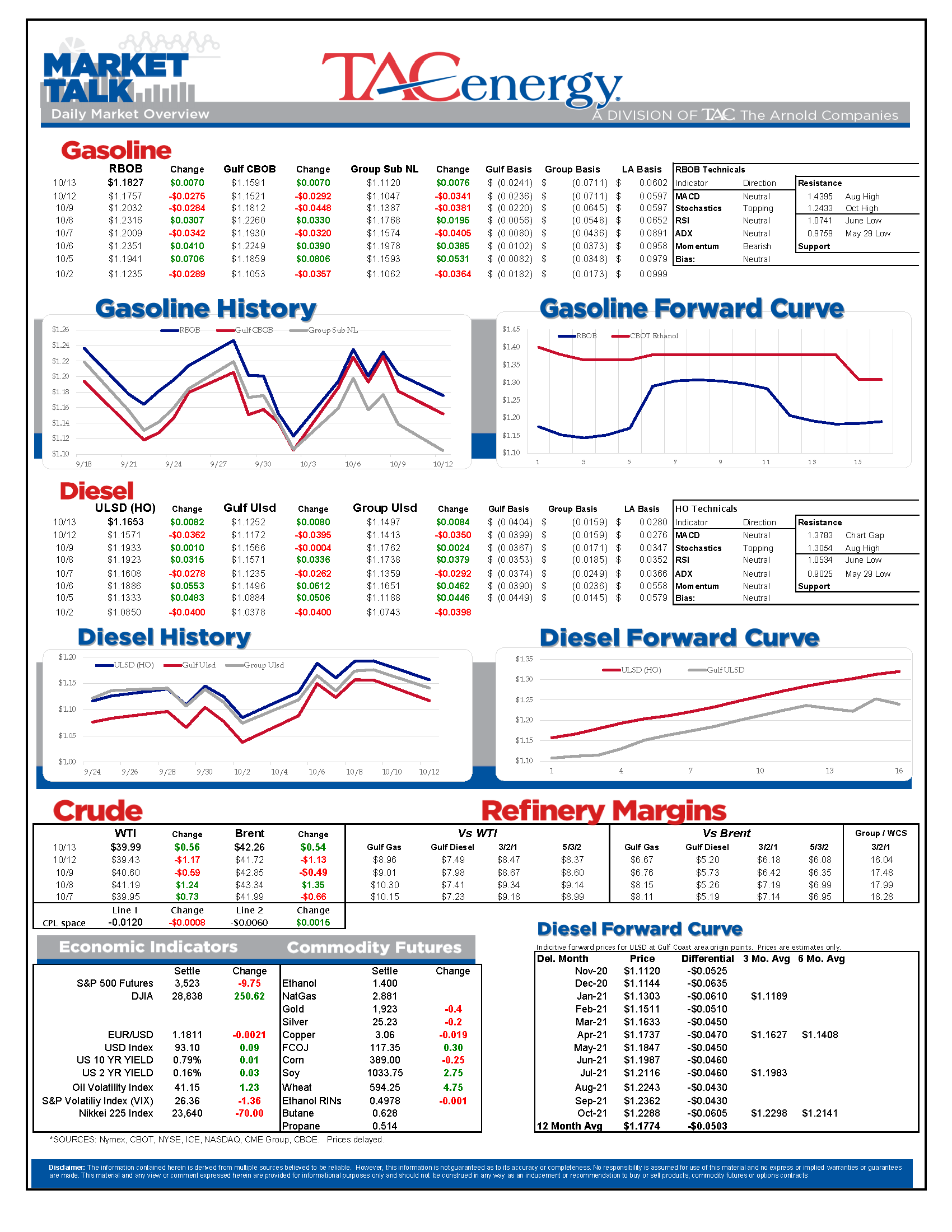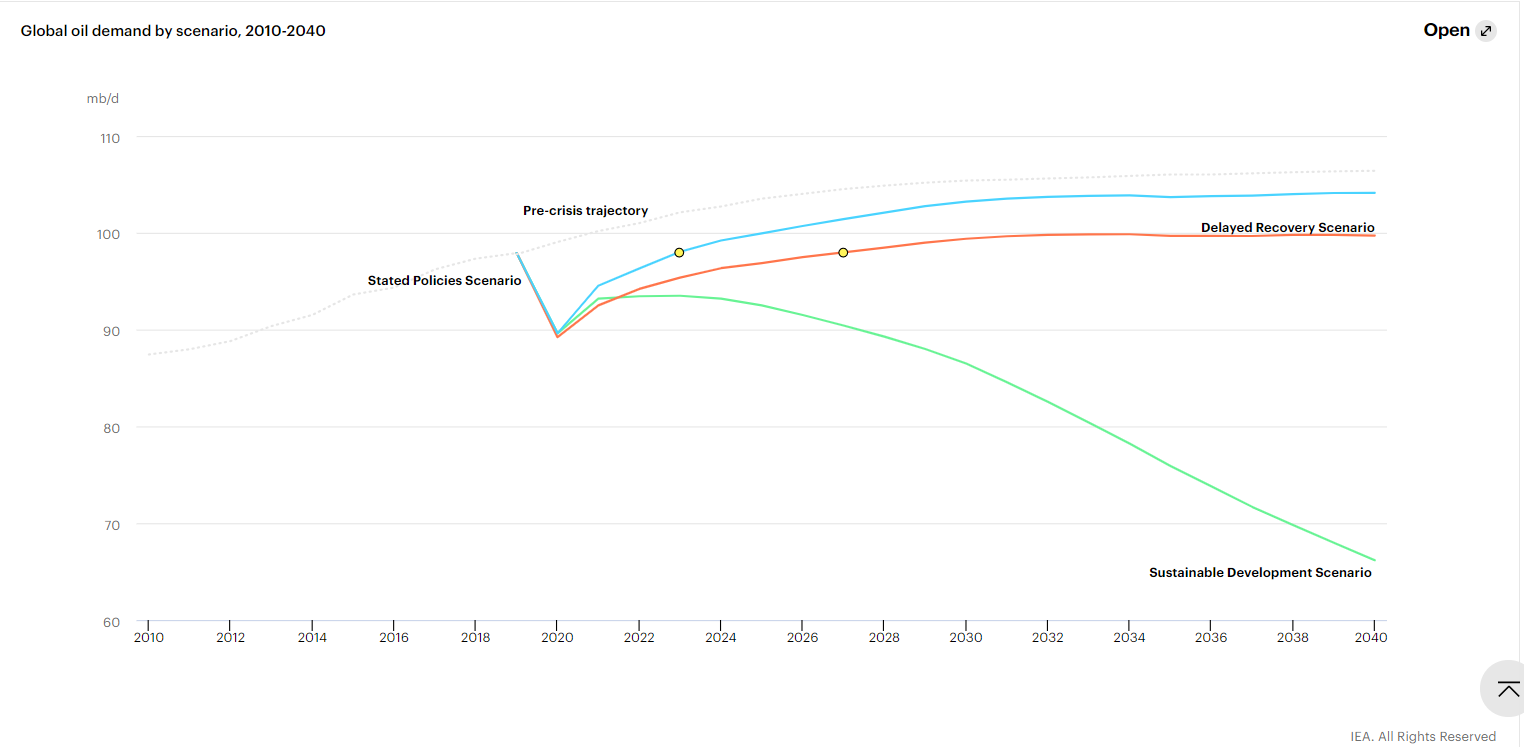Unplanned Outages Of Crude Oil Globally

There is more back and forth action for energy markets this week, leaving most contracts stuck in the sideways pattern that’s held them since June. Yesterday, easing supply concerns had energy futures moving lower, and today it appears to be demand optimism that has them trying to rally.
A surge in Chinese trade activity reported for September is giving markets around the world a boost as it sheds an optimistic light on the economic recovery from COVID, even as equity markets are taking a breather after a major vaccine trial hit a speed bump.
Early reports from Lake Charles suggest that both the Citgo and P66 refineries avoided major damage from Delta, and will restart operations within the next couple of weeks. Colonial pipeline confirmed its mainlines were both back in service as of Sunday night, which means we should not see any major supply issues from this storm.
The relative lack of movement in both futures and basis prices compared to previous years when multiple hurricanes hit refining country demonstrates how COVID-related demand destruction has created a substantial buffer for domestic fuel supply.
The IEA published its long term World Energy Outlook, highlighting several scenarios for both COVID recovery and environmental policies and how they’ll impact the supply & demand balance globally. The general theme, as with many IEA reports, is that countries around the world need to do much more to reduce emissions.
An EIA note this morning demonstrates how much worse the global glut of oil supply would be if Iran, Libya and Venezuela weren’t facing huge declines in output. Unplanned outages for crude oil production globally are at their highest level in nearly a decade, primarily due to those three countries, and combined with voluntary run cuts in, are succeeding in rebalancing the world market.
A few notes from the IEA’s World Energy Outlook:
There is a disparity in many countries between the spending required for smart, digital and flexible electricity networks and the revenues available to grid operators, creating a risk to the adequacy of investment under today’s regulatory structures.
Rising incomes in emerging market and developing economies create strong underlying demand for mobility, offsetting reductions in oil use elsewhere. But transport fuels are no longer a reliable engine for growth. Upward pressure on oil demand increasingly depends on its rising use as a feedstock in the petrochemical sector.
Not all the shifts in consumer behavior disadvantage oil. It benefits from a near-term aversion to public transport, the continued popularity of SUVs and the delayed replacement of older, inefficient vehicles.
The U.S. shale industry has met nearly 60% of the increase in global oil and gas demand over the last ten years, but this rise was fueled by easy credit that has now dried up. So far in 2020, leading oil and gas companies have reduced the reported worth of their assets by more than $50 billion.
Over the next ten years, lower emissions from urban power plants, residential heating units and industrial facilities in the SDS lead to falls of 45-65% in concentrations of fine particulate matter in cities, and cleaner transportation also brings down other street-level pollutants.
Click here to download a PDF of today's TACenergy Market Talk.
Latest Posts
Crude Oil Inventories Climbed Above Year-Ago Levels For The First Time In 2024
Week 17 - US DOE Inventory Recap
The Energy Complex Is Trading Modestly Lower So Far This Morning With WTI Crude Oil Futures Leading The Way
Energy Futures Are Drifting Quietly Higher This Morning
Social Media
News & Views
View All
Crude Oil Inventories Climbed Above Year-Ago Levels For The First Time In 2024
Sell by May then go away.
The old trading adage looked good for energy markets in 2024 as the new month started off with the biggest daily sell-off of the year so far. WTI and ULSD contracts are now in “rally or else” mode on the charts with sharply lower prices a strong possibility now that technical support layers have broken down. RBOB doesn’t look quite as bearish on the charts, but seasonal factors will now act as a headwind as we’re well into the spring peaking window for gasoline prices, and we’ve already seen a 27 cent drop from the highs. If RBOB can hold above $2.50 there’s a chance to avoid a larger selloff, but if not, a run towards $2.20 for both gasoline and diesel looks likely in the months ahead.
The selling picked up steam following the DOE’s weekly report Wednesday, even though the inventory changes were fairly small. Crude oil inventories continue their steady build and climbed above year-ago levels for the first time in 2024. Demand for refined products remains sluggish, even after accounting for the RD consumption that’s still not in the weekly reports, and most PADDs are following a typical seasonal inventory trend. The Gulf Coast saw a healthy build in diesel inventories last week as the export market slowed for a 3rd straight week. Refinery runs dipped modestly last week following a handful of upsets across the country, but overall rates remain near normal levels for this time of year.
The Transmountain pipeline expansion began operations yesterday, completing a 12-year saga that has the potential to materially change refining economics for plants in the US that relied heavily on discounted Canadian crude to turn profits over the past decade.
The P66 Borger refinery reported another operational upset Monday that lasted a full 24 hours impacting a sulfur recovery unit. Last week the company highlighted how the plant’s fire department helped the surrounding area when the largest wildfire in state history came within feet of the facility.
The EPA approved a new model to determine life cycle carbon intensity scores this week, which cracks open the door for things like ethanol to SAF, which were previously deemed to not reduce emissions enough to qualify for government subsidies. The new model would require improved farming techniques like no-till, cover crop planting and using higher efficiency nitrogen fertilizer to limit the damage done by farms that no longer rotate crops due to the ethanol mandates. Whether or not the theoretical ability to produce SAF comes to fruition in the coming years thanks to the increased tax credit potential will be a key pivot point for some markets that find themselves with too much RD today, but could see those supplies transition to aviation demand.
The FED continues to throw cold water on anyone hoping for a near term cut in interest rates. The FOMC held rates steady as expected Wednesday, but also highlighted the struggles with stubbornly high inflation. The CME’s Fedwatch tool gave 58% odds of at least one rate cut by September before the announcement, and those odds have slipped modestly to 54% this morning.

Week 17 - US DOE Inventory Recap

The Energy Complex Is Trading Modestly Lower So Far This Morning With WTI Crude Oil Futures Leading The Way
The energy complex is trading modestly lower so far this morning with WTI crude oil futures leading the way, exchanging hands $1.50 per barrel lower (-1.9%) than Tuesday’s settlement price. Gasoline and diesel futures are following suit, dropping .0390 and .0280 per gallon, respectively.
A surprise crude oil build (one that doesn’t include any changes to the SPR) as reported by the American Petroleum Institute late Tuesday is taking credit for the bearish trading seen this morning. The Institute estimated an increase in crude inventories of ~5 million barrels and drop in both refined product stocks of 1.5-2.2 million barrels for the week ending April 26. The Department of Energy’s official report is due out at it’s regular time (9:30 CDT) this morning.
The Senate Budget Committee is scheduled to hold a hearing at 9:00 AM EST this morning regarding a years-long probe into climate change messaging from big oil companies. Following a 3-year investigation, Senate and House Democrats released their final report yesterday alleging major oil companies have internally recognized the impacts of fossil fuels on the climate since as far back as the 1960s, while privately lobbying against climate legislation and publicly presenting a narrative that undermines a connection between the two. Whether this will have a tangible effect on policy or is just the latest announcement in an election-yeardeluge is yet to be seen.
Speaking of deluge, another drone attack was launched against Russian infrastructure earlier this morning, causing an explosion and subsequent fire at Rosneft’s Ryazan refinery. While likely a response to the five killed from Russian missile strikes in Odesa and Kharkiv, Kyiv has yet to officially claim responsibility for the attack that successfully struck state infrastructure just 130 miles from Moscow.
The crude oil bears are on a tear this past week, blowing past WTI’s 5 and 10 day moving averages on Monday and opening below it’s 50-day MA this morning. The $80 level is likely a key resistance level, below which the path is open for the American oil benchmark to drop to the $75 level in short order.
Click here to download a PDF of today's TACenergy Market Talk.



